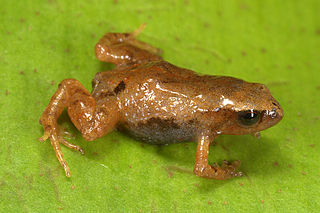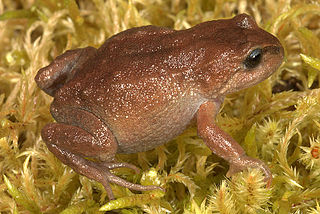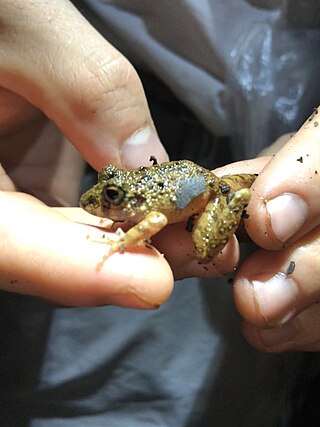Proctoporus is a genus of medium-sized lizards assigned to the family Gymnophthalmidae. Species in the genus Proctoporus occur in Yungas forests and wet montane grasslands on the upper edge of the Amazonian forest, between 1,000 and 4,000 metres elevation, from Central Peru in the north to Central Bolivia in the south.

Osteocephalus is a genus of frogs, the slender-legged tree frogs, in the family Hylidae found in the Guianas, the Amazon Basin, Venezuela, Colombia, southeastern Brazil, and north-eastern Argentina. Males are warty, while females are smooth.

Hyalinobatrachium is a genus of glass frogs, family Centrolenidae. They are widely distributed in the Americas, from tropical Mexico to southeastern Brazil and Argentina.

Oreobates is a genus of frogs in the family Strabomantidae. Most species were formerly in the genus Ischnocnema, but were moved to this revalidated genus following a 2006 revision. Its sister taxon is Lynchius.
Warren's tree frog is a species of frog in the family Hylidae found in Guyana and possibly Brazil and Venezuela. Its natural habitats are subtropical or tropical moist montane forests, rivers, freshwater marshes, and intermittent freshwater marshes.
Oreobates sanderi is a species of frog in the family Strabomantidae. It is found in north-western Bolivia and nearby south-eastern Peru. It is not considered threatened by the IUCN.
Oreobates saxatilis, also known as Tarapoto big-headed frog, is a species of frog in the family Strabomantidae. It is endemic to Peru and known from near its type locality near Tarapoto as well as from the Río Tambo District in the Satipo Province, Panguana in the Puerto Inca Province, and Río Kimbiri in the La Convención Province.
Lynchius simmonsi, also known as Simmons' big-headed frog, is a frog species in the family Strabomantidae. It is endemic to southern Ecuador where it is known from the type locality in the Cordillera del Cóndor, Morona-Santiago Province as well as from the adjacent Zamora-Chinchipe Province. Its natural habitat is subtropical old-growth forest. The type series was collected by day on the forest floor. The area was mined during the Cenepa War in 1995, and has consequently seen little human activity, although this may change through a proposed road.
Microkayla adenopleura is a species of frog in the family Strabomantidae. It is endemic to Bolivia and only known from near its type locality in the Carrasco National Park, Cochabamba Department, at elevations of 3,250–3,400 m (10,660–11,150 ft) asl. It is a common species living in low, humid montane forest typical to the transition between Yungas forest and páramo. Outside the national park, if present, it would be threatened by habitat loss.
Microkayla iatamasi is a species of frog in the family Strabomantidae. It is endemic to Bolivia and only known from near its type locality at the northern limit of the Carrasco National Park, Cochabamba Department, at elevations of 2,600–4,192 m (8,530–13,753 ft) asl. Its natural habitats are cloud forest, elfin forest, and humid páramo. It is considered to be an abundant species within its small distribution area. The latter makes it susceptible to stochastic events. In addition, climate change is a potential threat.
Oreobates pereger, also known as the Ayacucho Andes frog, is a species of frog in the family Strabomantidae. It is endemic to Peru where it is known from the eastern slopes of the Cordillera Oriental and Cordillera Vilcabamba mountain ranges.

The Strabomantidae are a family of frogs native to South America. These frogs lack a free-living larval stage and hatch directly into miniature "froglets". This family includes Pristimantis, the most speciose genus of any vertebrate.

Bryophryne is a genus of frogs in the family Strabomantidae. These frogs are endemic to south-eastern Peru in the Cusco Region, with an undescribed species from the Puno Region. Their range is separated from that of Phrynopus by the Apurímac River valley.
Proctoporus xestus, or the river teiid, is a species of lizard in the family Gymnophthalmidae. The species is endemic to South America.
Oreobates ayacucho is a species of frogs in the family Strabomantidae. It is endemic to Peru and known from a few localities in the Ayacucho Region in the Peruvian Andes. The species is only known from 11 specimens.

Yunganastes is a small genus of frogs in the family Strabomantidae found in southern Peru and central to northern Bolivia. They were formerly placed in the genus Eleutherodactylus as the "Eleutherodactylus fraudator group", subsequently moved to Pristimantis, before becoming recognized as a separate subgenus, and finally, a genus. Its sister taxon is the genus Pristimantis. Yunganastes are endemic to the cloud forests and humid montane forests of the Cordillera Oriental of the Andes in Bolivia and southern Peru.

Dryaderces is a small genus of frogs in the family Hylidae. Their known distribution is disjunct, with one species found in the upper Amazon Basin and lower Andean slopes between central Peru and Amazonian Bolivia, and another one in Pará, Brazil. Its sister taxon is Osteocephalus. No phenotypic synapomorphies defining the genus are known.

Oreobates amarakaeri, also known as Amarakaeri's big-headed frog is a species of frog in the family Strabomantidae, which is endemic to a small region of south-eastern Peru, in the Manú District, and parts of the Puno Region. The frog was first discovered near the Rio Nusinuscato and Rio Mabe rivers in the Andean foothills of the Amarakaeri Communal Reserve, which are tributaries of the Rio Araza. Since then the species has also been found at the Manú Learning Centre and near Bahuaja Sonene National Park, but weren't fully confirmed to be there until 2019 when four specimens were collected at those localities. At the Manú Learning Centre the frog is known to occur mainly in low disturbance and primary forest habitat, but can also be found near streams in more disturbed areas.
Phyllomedusa chaparroi is a species of treefrog in the subfamily Phyllomedusinae endemic to Peru. Scientists have only seen it in two places.







